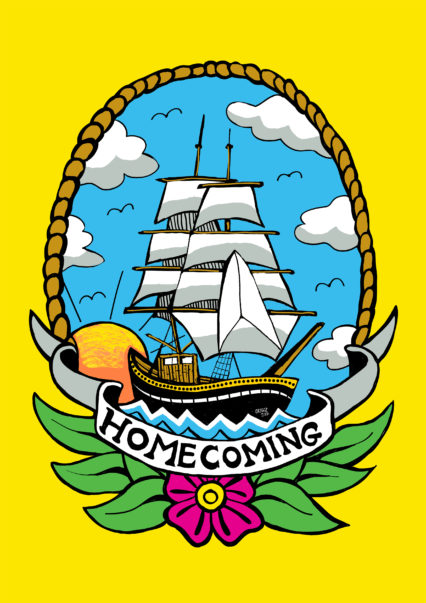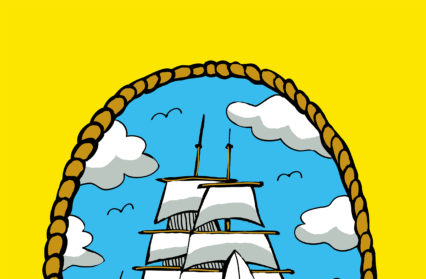Siân Norris presents a story as part of her residency here at Wales Arts Review for A.i.R, Homecoming which highlights the importance of home & homecoming. Throughout 2017 these artists, including Siân Norris will take a leading creative role in what Wales Arts Review publishes, centring their skills on a challenging project over the course of a month. We were inundated with applications, receiving hundreds of emails about the positions, and it was no easy task whittling down all that talent to this final eleven. Our team of six editors debated long into the night, and in the end, we decided on a collection of people who we most want to work with, and whose work excites us. We think you will be excited by them too.
For similar content like Homecoming by Siân Norris, take a look at her other pieces she has contributed to Wales Arts Review.
Homecoming by Siân Norris

They’d docked in the historic city harbour the week before. Arriving was always a shock. They all needed a few days to adjust back to land; to adjust back to homeland. So they tentatively left the motion of the deck to spend days walking up and down the solid pavements, peering confused at the overwhelming numbers of people crowding into the city streets. When dusk fell they’d drink in bars, gaping in awe of strangers’ faces. What a brave new world.
Work didn’t stop because they’d docked. The boat needed painting, and so she spent hour after hour, the ropes cradling her back, arms outstretched and eyes squinting up at the grey paint and the grey sky, ignoring the dirty dishwater river that rippled mere metres beneath her back.
She’d almost given herself away. ‘No, it’s this way,’ she’d said to a colleague when the two ventured out that first evening looking for a bar. ‘How d’you know, you been here before?’ She shook her head, quick, too quick. He didn’t ask again. There was an agreement not to ask too much. The past was left on the land. No one needed to know how the streets of this city were as familiar to her feet, as the ropes were now familiar to her hands.
‘Are you scared?’ a small voice piped up.
A girl stood and looked at her with a quizzical expression on her face.
‘Yes,’ she replied. ‘I’m always scared. It’s wise, to be scared.’
‘I wouldn’t be scared,’ the girl boasted, chin defiantly.
‘Oh,’ she said. ‘You would.’
Had it only been a few weeks since she’d dived off the boat into water that lay still and silky and ten feet deep under a hot western sun? On the green sea’s floor, someone had placed eerie sculptures of drowned men and women. She’d swum away, kicking her feet in the panic of the pursuit. She was always ill at ease with the space between the surface and the seabed. The colours and the corals and the shoals that warped until you thought they would brush against your flesh in a cold, slippery assault.
How easy it would be to lose your head in that cold, still space.
She was a strong swimmer, now. She was strong enough to jump from the boat and submerge herself in the ocean before pushing back up; nose spluttering and eyes blinking in outrage. Her ears would ring with the fear that this time, this time, she would not come back. That this time her head would go, her neck would snap, and she’d stay, suspended, between the surface and the seabed, another sculpture.
She’d bought a postcard in the small port town and written a few lines to her mother. She did this, sometimes. Only in the towns where she thought of her.
It was hard to believe that water so green and clear could be made of the same stuff as the dirty dishwater river below.
They’d left that small port town with its lazy fishing and hectic tourism, and sailed eastwards back home. The further east they went, the more the sea raged and raved in swirls of grey and black. The fish changed to match the colours of the waves, and sometimes she saw dolphins and sometimes she saw porpoises, but mostly she saw birds. Lying on her back on the ropes, she watched the fulmars with their straight wings, the kittiwakes with their round heads, the terns with their long migrations, and the gannets with their concentrated dives. People thought you went to sea because you loved the water but she had learnt quickly to look up. Always to look up.
‘Aren’t you scared?’ one of her colleagues had asked her.
The evening was coming in and her arms ached with the effort of painting. The little girl had gone and instead crowds of people were gathering in search of pubs and bars. Men loud in shirts and shoes, women loud in dresses and heels. The performative raucousness of a hen do, the performative machismo of a stag do.
She could leave her cradle of ropes. She could go to shore. She could go and look…
What response would she get, if her feet followed the streets to the old familiar front door? What response, when she couldn’t even get an answer to a postcard?
‘Why do you want to go?’ had been the question. ‘Why would you want to go… out there?’
‘Because,’ she’d replied. ‘Because it’s something I need to do.’
‘But it’s so dangerous,’ she’d said, a tremor audible in her voice. ‘You, who know better than anyone, just how dangerous.’ Her eyes were wet to match the tremor; her face contorted with memories. ‘Don’t go,’ she said, her voice meek.
‘I’ll be fine,’ she’d lied. It was always a lie. How could anyone promise that?
*
*
*
*
*
*
*
*
She was first in the sea because she always was. It pulled her in like the moon pulled at the tides. He’d been slower, dangling his feet in the shallows where the waves broke with a hundred bubbles that melted into the solid sand. They’d swam and splashed and then it was time to eat sandwiches, and then it was time to jump off sand dunes, and then it was time to dig a hole, and then it was time to go into the sea again.
Other families had beach paraphernalia. They never did. They dug holes with their hands. They jumped off sand dunes with their feet. They didn’t need props. They didn’t need stuff. They had the beach, and the sand, and the sea.
It was a hot day, but it never really got that hot, and their skin was sticky with sun lotion and gritty with sand. They’d go back into the sea to try and wash the sand off, but the waves picked up more sand and wrapped them in it. Sand cracked between teeth and embedded under nails and tangled in hair, ready to stick to the ceramic sides of the bath water.
They picked up seaweed and threw it at each other, yelling ‘jellyfish’. There were real jellyfish too, washed up on the beach, don’t step on one, they can still sting even when they’re dead, tiny painful red welts on the soles of feet.
The waves were big and loud. They jumped over the shallow breakers; dared one another to move further out where the waves were bigger and louder. ‘I can feel the current sucking at my feet’ they yelled in joyful terror. They turned away from the horizon and faced the beach, jumping as each wave hit their backs with the surprising and thrilling force. It was a thrill, the two of them against the ocean, feeling the slap of water against little bodies.
She turned to tell him something to laugh at. Just a wave where he had stood.
*
*
*
*
*
*
*
*
After hours lying suspended in rope, the grey pavement felt uncanny under her feet. She walked through the city where she had once lived, tracing the steps she used to take from home to work, from work to bar. She tried not to look at the faces that crowded around her. It was hopeless. She couldn’t stop herself from peering and searching for someone, anyone, who knew. Her hands shook in anticipation at the shock of recognition, readying herself for when it may come.
But she found no one there to recognise. No one there to recognise her.
In a week, they’d leave this place and go back out to the ocean. In a week, she’d be arms climbing rope, feet balancing on wooden planks, eyes looking up at birds. In a week she’d be back in the comfort of her own familiar fear.
This piece, Homecoming by Siân Norris is part of the Artists in Residence series.
For similar content like Homecoming by Sian Norris, take a look at her other pieces she has contributed to Wales Arts Review.
(The Homecoming Image is by Robert Griggs)












